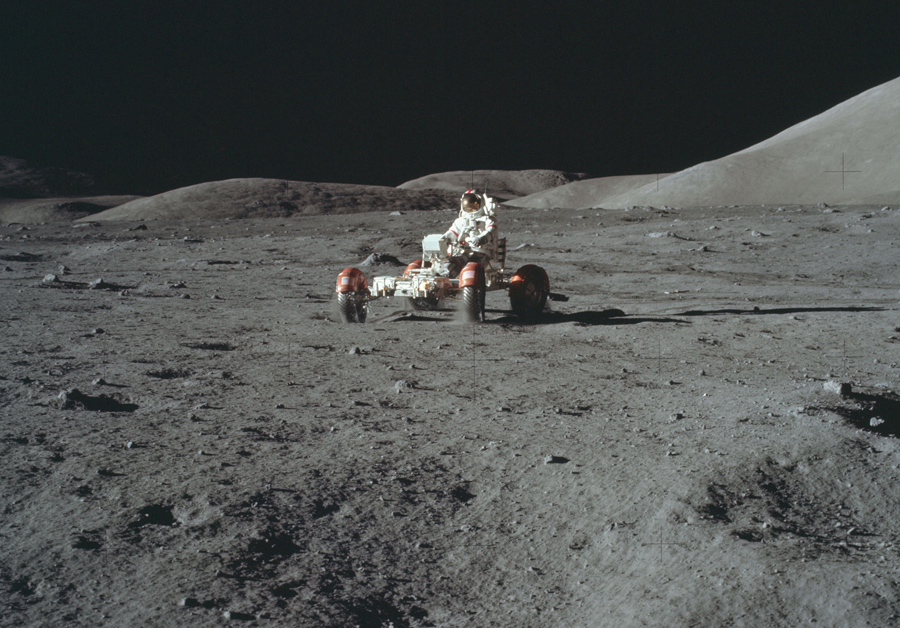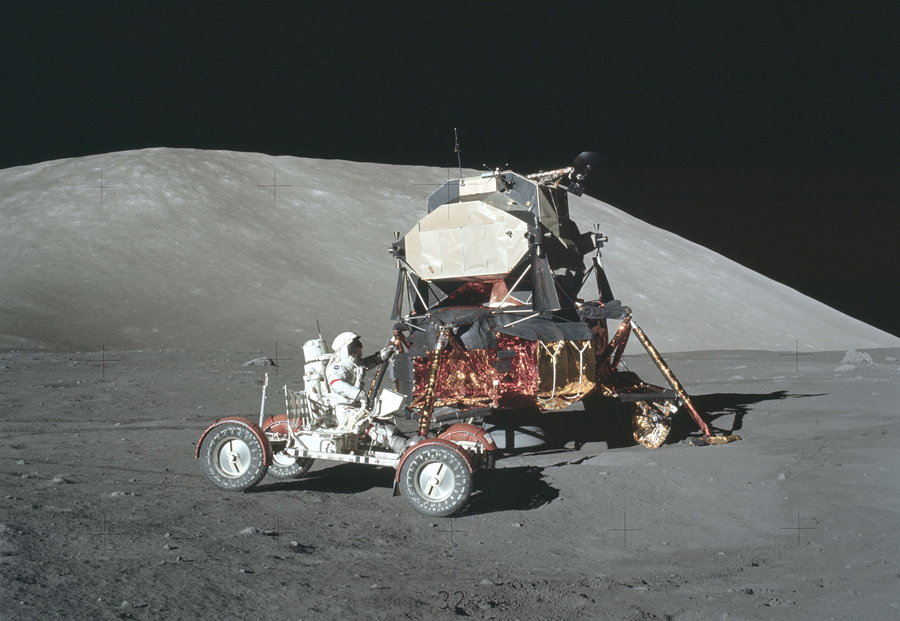On September 27, as the full Moon reached its closest point to Earth, it was also dimmed by a total lunar eclipse. This Supermoon eclipse lasted one hour and 12 minutes, and, according to NASA, was “visible to North and South America, Europe, Africa, and parts of West Asia and the eastern Pacific.” While preparing to look up into the night sky and view this once-every-few-decades event, I found a treasure trove of lunar photography from the Project Apollo Archive, which just recently posted hundreds of unprocessed film scans from Apollo-mission Hasselblad cameras to its Flickr account.
 In December of 1972, Astronaut Eugene Cernan, commander of Apollo 17, takes a spin on the Lunar Roving Vehicle (LRV) during the first Apollo 17 Extravehicular Activity (EVA-1) at the Taurus-Littrow landing site. Hasselblad image from film magazine 147/A.Project Apollo Archive / NASA
In December of 1972, Astronaut Eugene Cernan, commander of Apollo 17, takes a spin on the Lunar Roving Vehicle (LRV) during the first Apollo 17 Extravehicular Activity (EVA-1) at the Taurus-Littrow landing site. Hasselblad image from film magazine 147/A.Project Apollo Archive / NASA Earth rises beyond the Moon and the Apollo 11 Eagle ascent stage, as it approaches the command module Columbia in July of 1969. Hasselblad image from film magazine 44/V - LM inspection, rendezvous.Project Apollo Archive / NASA
Earth rises beyond the Moon and the Apollo 11 Eagle ascent stage, as it approaches the command module Columbia in July of 1969. Hasselblad image from film magazine 44/V - LM inspection, rendezvous.Project Apollo Archive / NASA Apollo 15 astronaut Dave Scott samples a boulder on the rim of Hadley Rille, photographed by Lunar Module Pilot, Jim Irwin reflected in Scott's visor, in August of 1971. Hasselblad image from film magazine 82/SS - EVA-3.Project Apollo Archive / NASA
Apollo 15 astronaut Dave Scott samples a boulder on the rim of Hadley Rille, photographed by Lunar Module Pilot, Jim Irwin reflected in Scott's visor, in August of 1971. Hasselblad image from film magazine 82/SS - EVA-3.Project Apollo Archive / NASA Apollo 12 Commander Pete Conrad stands beside the Surveyor 3 lander, a NASA probe that had touched down in April of 1967, two years earlier, on a section of the Moon’s Ocean of Storms. Hasselblad image from film magazine 48/X - EVA-2Project Apollo Archive / NASA
Apollo 12 Commander Pete Conrad stands beside the Surveyor 3 lander, a NASA probe that had touched down in April of 1967, two years earlier, on a section of the Moon’s Ocean of Storms. Hasselblad image from film magazine 48/X - EVA-2Project Apollo Archive / NASA Apollo 17 Lunar Module Pilot Harrison Schmitt poses with an American flag and Earth in the background during Apollo 17's first EVA in December of 1972. Hasselblad image from film magazine 134/B - EVA-1 & 3.Project Apollo Archive / NASA
Apollo 17 Lunar Module Pilot Harrison Schmitt poses with an American flag and Earth in the background during Apollo 17's first EVA in December of 1972. Hasselblad image from film magazine 134/B - EVA-1 & 3.Project Apollo Archive / NASA

























댓글 없음:
댓글 쓰기